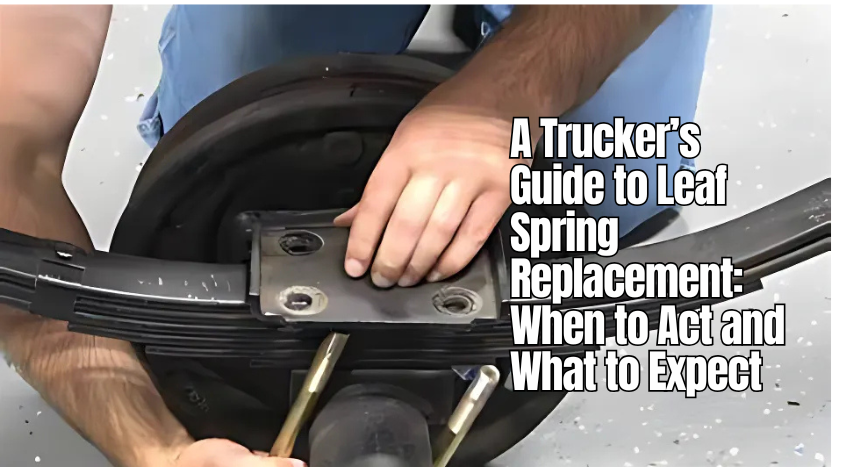If your ride feels rougher than usual or your trailer’s sitting a little off, it might not be your imagination — it could be your leaf springs telling you they’re done. These unsung heroes of your suspension system do the heavy lifting, literally. And when they wear out, they don’t just make your ride uncomfortable — they put your safety, load stability, and truck performance at risk.
Here’s what every truck driver should know about spotting leaf spring issues, replacing them, and keeping your rig rolling smoothly.
Why Leaf Springs Matter So Much
Your semi-truck’s leaf springs absorb road shocks and help distribute weight evenly across your axles. They’re especially crucial when you’re hauling heavy loads across rough stretches of highway. Over time — and miles — they wear down, crack, or even snap.
Ignoring them can lead to:
- Uneven tire wear
- Damaged axles
- Poor handling
- Costly repairs down the line
How to Tell When It’s Time for New Leaf Springs
Sometimes your truck speaks up before a part fails completely — you just have to know how to listen. Here are the top red flags:
- Sagging in the rear – The rear end of your truck appears to be lower than it should be, even when empty.
- Uneven stance – One side sits lower than the other? That’s usually a broken or worn spring.
- Extra bouncing – Your truck feels floaty after bumps, especially when unloaded.
- Rougher ride – You’re feeling every crack and bump in the road more than usual.
- Clunking or squeaking – Sounds from the rear suspension, typically heard during turns or acceleration.
- Visible damage – Cracks, corrosion, missing clips, or a broken leaf.
What Impacts Leaf Spring Longevity?
The lifespan of your springs depends on how you use your truck. A few major factors:
- Load weight – Running near the maximum gross vehicle weight rating (GVWR) regularly accelerates wear.
- Road conditions – Potholes and rough roads chew through suspension systems fast.
- Climate – Salt, snow, and moisture can cause rust and premature failure.
- Maintenance – Like everything else on your rig, inspecting often can save you thousands.
Step-by-Step: Replacing Leaf Springs on a Semi
Disclaimer: If you’re not comfortable working under 20+ tons of metal, leave this one to the pros. But for those mechanically inclined, here’s the basic outline:
- Get prepped: You’ll need jack stands, a hydraulic jack, a wrench set, a torque wrench, new leaf springs, bushings, bolts, and safety gear.
- Raise and secure the truck: On level ground, lift the rear of the truck with a jack and secure it with stands. Don’t skip this step — stability is everything.
- Remove the old spring: Unbolt the U-bolts and shackles carefully. A pry bar might help if it’s seized up.
- Inspect hardware: If your bushings or bolts look worn, replace them too.
- Install the new spring: Align everything with care. Torque bolts according to spec.
- Lower and test: Lower the truck, take it for a short test drive, and listen closely for any unusual noises.
- Check alignment: A misaligned suspension can wear out tires — it’s worth having it checked.
How Much Does Leaf Spring Replacement Cost?
According to RepairPal, drivers can expect to pay:
- Parts: $550–$600
- Labor: $175–$220
- Total: Around $730–$825 on average
These numbers can climb depending on your truck model and if you’re dealing with tandem axles or added suspension damage.
DIY vs. Professional: Which Way Should You Go?
While some experienced drivers swap their own springs, most drivers opt for a repair shop, and for good reason. Leaf spring replacement isn’t a beginner-level job. It involves heavy lifting, safety risks, and exact torque specs. A bad installation can lead to poor handling or worse, catastrophic failure on the road.
Bottom line? Unless you know exactly what you’re doing, let a suspension tech handle it.
Pro Tips to Extend the Life of New Leaf Springs
- Don’t overload – Keep it within your axle weight ratings.
- Rinse the undercarriage – Especially after salty or muddy routes.
- Grease fittings – If equipped, keep them lubed.
- Inspect monthly – Look for cracks, leaks, or sagging.
If your truck is giving you signs, such as sagging, bouncing, or weird noises, listen. Leaf springs take a beating, and when they fail, they don’t always give you a second chance.
Staying on top of suspension maintenance isn’t just about ride comfort; it’s about protecting your equipment, cargo, and safety.











